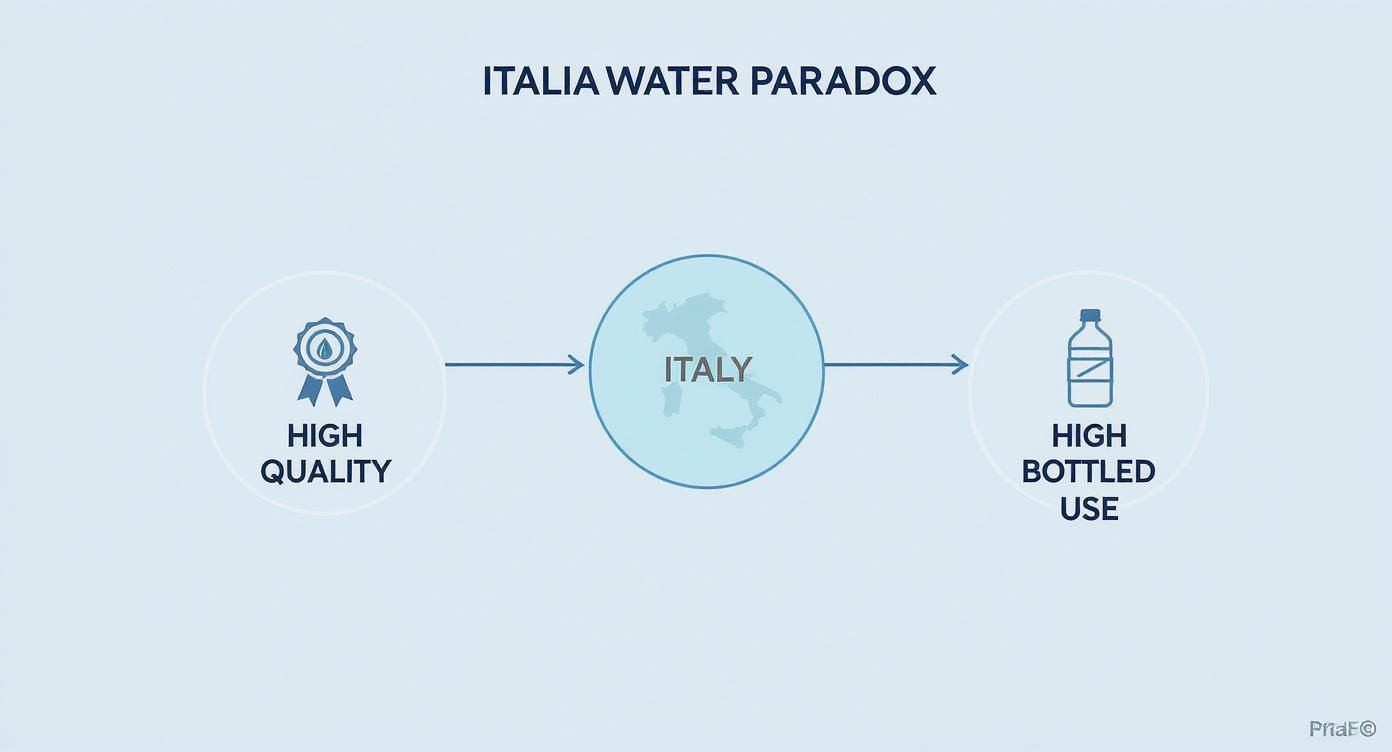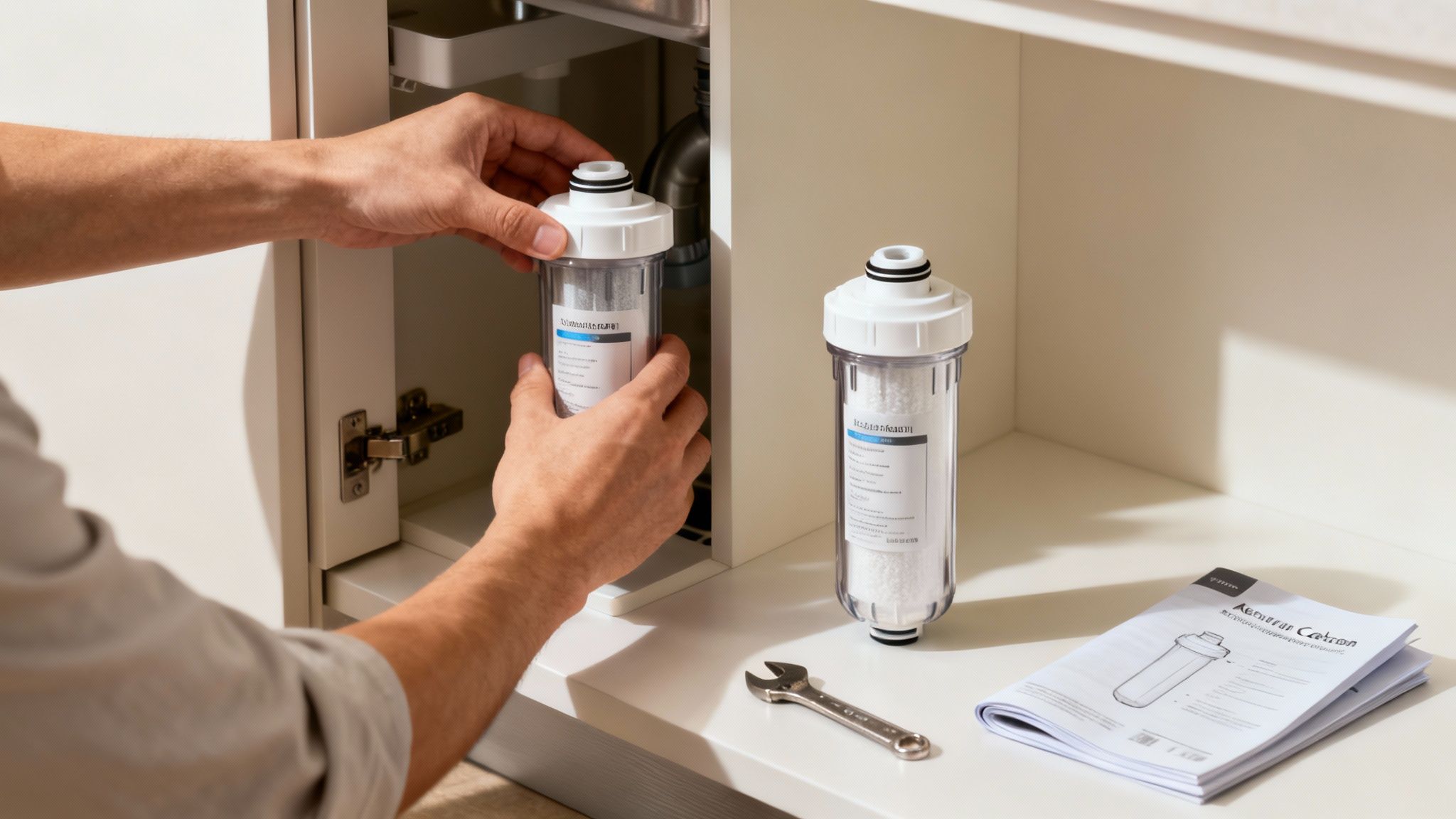
A Practical Guide to Acqua da Bere at Home
Share
Getting clean, great-tasting acqua da bere (drinking water) at home should be simple. While tap water in Italy is generally safe, many people still have concerns. The taste of chlorine or the annoying limescale buildup from hard water can be off-putting. This often pushes people towards bottled water, a choice that adds up in cost and plastic waste. A simple home filter offers a reliable solution.
Quick Answer: Yes, Italian tap water is safe to drink. However, a good home water filter improves its quality significantly. It helps reduce common contaminants like chlorine and limescale, removing unpleasant tastes and odours. This gives you better-tasting water directly from your tap, saving money and reducing plastic waste.
Why Do We Distrust Our Tap Water?
Italians have a complex relationship with their tap water. The country has high-quality water, yet the habit of buying bottled water is deeply ingrained. This guide provides a clear look at Italian tap water. We will explore common issues, explain how home filtration works, and present simple solutions. Our goal is to help you feel confident about enjoying healthier, better-tasting water from your kitchen.

The Reasons Behind the Habit
What drives this preference for bottled water? A big part of it is taste and smell. Municipalities use chlorine for disinfection. It’s essential for safety, but it can leave a chemical taste. Limescale, from hard water, is another common issue. While not a health risk, it can affect the flavour of coffee and damage appliances. For simple ways to improve your daily hydration, see our Knowledge Hub.
Marketing has also painted bottled water as a purer, healthier choice. This idea has stuck, even though modern home filtration offers excellent quality without the plastic waste. This guide will show you how easy it is to get amazing water from your own tap.
What's Really in Your Tap Water?
When you fill a glass with acqua da bere from your tap, you're getting more than just H₂O. Italian municipal water is safe, but it contains various substances. Knowing what these are helps you improve the water you drink every day.
The most common addition is chlorine. Water suppliers use this disinfectant to eliminate harmful bacteria. The downside is the distinct "tap water" taste and smell. Then there’s limescale, a build-up of harmless minerals like calcium and magnesium. These cause "hard water," leaving chalky deposits on your kettle and coffee machine.
From Old Pipes to Modern Contaminants
The journey water takes can introduce other elements. In older buildings, plumbing can be a problem. Lead or copper pipes may leach small amounts of metal into the water. Other substances can also be present in small amounts.
- Sediment: Tiny bits of sand or rust that can make water cloudy.
- Volatile Organic Compounds (VOCs): Industrial chemicals that can seep into water sources and affect taste.
- Microplastics: A growing concern, these tiny plastic fibres are found in tap water globally.
This is where home filtration shines. Different filter technologies capture specific substances. For most homes, activated carbon is a highly effective solution. Think of it as a sponge with a huge surface area that traps chlorine and VOCs, letting cleaner water flow through. It improves taste and smell without removing beneficial minerals.
Disclaimer: Home filtration complements—not replaces—professional advice.
Filtered Tap vs. Bottled Water: A Realistic Comparison
Many people assume bottled water is the purer choice. But how does it compare to filtered tap water for your daily acqua da bere? Let's look at the real-world trade-offs. We will explore the environmental impact of single-use plastics and the recurring costs. We'll also see the convenience and quality a home water filter provides.
Cost, Convenience, and Environmental Impact
The price difference is significant. A family can easily spend hundreds of euros each year on bottled water. In contrast, a tap filter is a one-time investment with small ongoing costs for replacement cartridges. The convenience is also clear. A filter gives you an endless supply of fresh water from your tap. No more carrying heavy packs from the supermarket.
The environmental cost of bottled water is enormous. Its production, transport, and disposal create a large carbon footprint. Switching to a home filter is a simple way to reduce your household's plastic waste.
Side-by-Side Comparison Table
This table breaks down the key differences between bottled water and a home filtration system. Compare options with our quick table.
| Feature | Filtered Tap Water | Bottled Water |
|---|---|---|
| Annual Cost | Low (initial filter + 2-4 cartridges/year) | High (€200-€500+ for a family) |
| Environmental Footprint | Very Low (minimal waste from cartridges) | High (plastic waste and CO₂ emissions) |
| Convenience | Excellent (unlimited water on demand) | Poor (requires shopping, transport, and storage) |
| Water Quality | Consistent & Fresh (filtered just before use) | Variable (can be stored for long periods) |
| Contaminant Control | Targeted (designed to capture chlorine and more) | Regulated, but no protection from home pipes |
Filtering your tap water is a more sustainable, cost-effective, and convenient way to get high-quality acqua da bere.
How to Choose the Right Water Filter
Choosing the right filter for your acqua da bere doesn't have to be complicated. For most homes, a point-of-use system that attaches to your kitchen tap is the simplest and most effective solution. These filters are designed to handle common water quality issues.
The core technology is usually activated carbon. This material is extremely porous and acts like a magnet for impurities. It is excellent at reducing the chlorine that causes unpleasant tastes and smells. It also helps capture sediment and certain VOCs, delivering a cleaner, crisper glass of water.
A Practical Checklist for Your Decision
Use this checklist to find a filter that fits your lifestyle and needs.
- Easy Installation: Can you install it yourself in minutes without a plumber? Tap-mounted filters are usually very simple to set up.
- Contaminant Reduction: Does it address your main concerns, like chlorine taste or limescale?
- Maintenance Costs: What is the price of a replacement cartridge and how often is it needed? Calculate the annual cost.
- Flow Rate: How quickly does the water flow? A good flow rate (measured in litres per minute) means no long waits to fill a glass.
- Filter Lifespan: How many litres can the filter process before it needs changing?
- Aesthetics: Does it fit your kitchen's style and your tap?
- Certifications: Is the filter independently tested and certified to confirm its performance?
Considering these points will help you find a great solution. See the Water Filters kit that installs in minutes.
Installing and Maintaining Your Filter
Modern water filters are designed for easy DIY installation. Most tap-mounted or under-sink systems can be set up in minutes without special tools. This section walks you through the setup and simple maintenance routine.

Installing a Tap Filter
Tap-mounted filters are incredibly easy to fit. They come with adaptors to fit standard kitchen taps.
- Remove the Aerator: Twist off the small mesh screen at the end of your tap.
- Find the Right Adaptor: Choose the correct threaded adaptor from the kit and screw it on by hand.
- Attach the Filter: Screw the main filter unit onto the adaptor until it feels secure.
- Flush the System: Run cold water through the filter for about five minutes. This activates the carbon and clears out any harmless loose particles.
You are now ready to enjoy freshly filtered water.
Simple Maintenance Checklist
Looking after your filter is crucial for consistent performance. The cartridge traps contaminants and needs regular replacement.
- Track the Lifespan: Note when you install a new cartridge. Most have a filter lifespan of 3-6 months.
- Order Replacements: Keep a spare cartridge on hand. Check sizes & refills — fast EU shipping.
- Easy Swap: Changing a cartridge is a simple twist-off, twist-on process.
- Keep it Clean: Wipe the filter's casing with a damp cloth when you change the cartridge.
Proper maintenance ensures your water is always pure and great-tasting. It also helps protect your appliances from limescale. A similar principle applies to other areas of your home; learn how a Shower Filter can benefit your skin and hair. Our Shipping Policy ensures you get your supplies quickly.
Frequently Asked Questions About Acqua da Bere
Here are answers to common questions about drinking water in Italy and home filtration. This advice is for general guidance. For specific health or plumbing concerns, consult a professional.
Is Italian tap water safe to drink without a filter?
Yes, absolutely. Tap water in Italy is highly regulated and safe to drink. A filter simply improves it. It helps reduce the chlorine taste and acts as a final barrier against sediment or contaminants from older pipes, giving you better-tasting water and extra peace of mind.
How often should I change the filter cartridge?
A good rule of thumb for a tap filter is every three to six months. This depends on the model and your household's water usage. Sticking to the manufacturer's schedule is essential to ensure the filter works effectively. You can find replacement parts in our Refills & Cartridges collection.
Will a water filter remove healthy minerals?
No. Standard activated carbon filters are designed to target unwanted substances like chlorine and certain chemicals. They leave beneficial minerals like calcium and magnesium in the water. You get purer-tasting water without losing its natural mineral content.
What is the difference between a tap filter and a shower filter?
They have different jobs. A tap filter is for drinking water, focusing on improving taste and smell with a lower flow rate. A Shower Filter handles a much higher flow of hot water. Its main purpose is to reduce chlorine and limescale, which can dry out skin and hair, making for a softer shower experience.